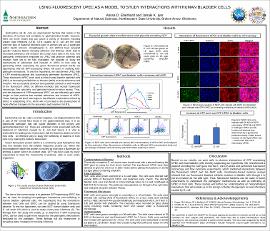| dc.contributor.advisor | Iyer, Janaki K. | |
| dc.contributor.author | Eberhard, Alissa D. | |
| dc.contributor.other | Northeastern State University | |
| dc.date.accessioned | 2021-09-29T14:29:39Z | |
| dc.date.available | 2021-09-29T14:29:39Z | |
| dc.date.issued | 2021-10-09 | |
| dc.identifier | oksd_OK-LSAMP_2021_eberhard | |
| dc.identifier.citation | Eberhard, A. D., & Iyer, J. K. (2021, October 9). Using fluorescent UPEC as a model to study interactions with human bladder cells. Poster presented at the Oklahoma Louis Stokes Alliance for Minority Participation's 27th Annual Research Symposium, Stillwater, OK. | |
| dc.identifier.uri | https://hdl.handle.net/11244/330995 | |
| dc.description.abstract | Escherichia coli (E. coli) are opportunistic bacteria that reside in the intestines of humans and contribute to gastrointestinal health. However, there are some strains that can cause a variety of diseases including urinary tract infections (UTIs). UTIs caused by E. coli are the most common type of bacterial infections seen in women and are a significant public health concern. Uropathogenic E. coli (UPEC) have acquired specific virulence factors including adhesions and fimbriae, which lead to increased adherence and invasion into urinary tract cells in the host. The pathogenic mechanisms employed by UPEC that promote adhesion and invasion have yet to be fully elucidated. We propose to study the mechanisms of adherence and invasion of UPEC to host cells by generating UPEC expressing the green fluorescent protein (GFP). we hypothesize that the GFP-expressing UPEC will assist in studying host-pathogen interactions. To test this hypothesis, we transformed UPEC with a GFP encoding plasmid and successfully generated fluorescent UPEC. These fluorescent UPEC were used to infect human bladder epithelial cells (5637) at increasing multiplicities of infection (MOI) to study adherence and invasion. We successfully detected and quantified adherence and invasion of the fluorescent UPEC by different methods that include fluorescent microscopy, flow cytometry, and gentamicin-based invasion assays. Thus, with the assistance of GFP-expressing UPEC, we can efficiently gain more insight on host proteins that mediate adherence and invasion of UPEC. These findings will shed more light on the different mechanisms utilized by UPEC in establishing UTIs, which will in turn lead to the development of more effective therapies for the prevention and treatment of UTIs. | |
| dc.description.sponsorship | Oklahoma Louis Stokes Alliance for Minority Participation Program | |
| dc.description.sponsorship | National Science Foundation (U.S.) | |
| dc.description.sponsorship | Northeaster State University. Faculty Research Council Grant | |
| dc.format | application/pdf | |
| dc.language | en_US | |
| dc.publisher | Oklahoma State University | |
| dc.rights | In the Oklahoma State University Library's institutional repository this paper is made available through the open access principles and the terms of agreement/consent between the author(s) and the publisher. The permission policy on the use, reproduction or distribution of the article falls under fair use for educational, scholarship, and research purposes. Contact Digital Resources and Discovery Services at lib-dls@okstate.edu or 405-744-9161 for further information. | |
| dc.title | Using fluorescent UPEC as a model to study interactions with human bladder cells | |
| osu.filename | oksd_OK-LSAMP_2021_eberhard.pdf | |
| dc.description.department | Natural Sciences | |
| dc.type.genre | Poster | |
| dc.type.material | Text | |
| dc.subject.keywords | bacteria | |
| dc.subject.keywords | fluorescent | |
| dc.subject.keywords | uti | |
| dc.subject.keywords | invasion | |
| dc.subject.keywords | adherence | |
